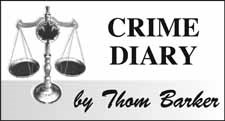Alas, I have turned the final page on my Murdoch Mysteries summer reading marathon. It is a rarity that seven books-actually 11 if you include the two Tom Tyler and two Christine Morris mysteries-by a single author would leave me wanting more, but Maureen Jennings, in addition to telling compelling crime stories, has a real knack for bringing Victorian-era Toronto to life.
Of course, I cannot be certain how authentic it actually is, but it really feels authentic, a tribute to Jennings' prodigious research capability.
And the William Murdoch character himself feels more authentic than in the TV series. He is a forward-thinking detective to be sure, but not the genius inventor portrayed by Yannick Bisson on CBC. In the books, he is a practitioner of Bertillon measurements, which, in 1895 and 1896 when the series takes place, was about as far as forensic identification had come.
Prior to the widespread adoption of fingerprint identification anthropometry, the careful measurement and recording of body features such as length of head, breadth of head, length of middle finger etc. was used to positively identify criminals. French criminologist Alphonse Bertillon was the first to apply the technique to law enforcement.
The Murdoch Mysteries are chock full of interesting details about criminal justice like that. For example, apparently police, at least in Toronto, used to round up coroner's juries (all men of course) immediately when a sudden death was discovered so the jurors could see the body in situ before it was hauled off for the post mortem.
Jennings weaves these details into the narrative with a light hand.
The thing I like best about her writing, though, is that she captures the attitudes about crime in the period.
Criminology, the science of why people commit crime was in its infancy in nineteenth century and the prevailing theory was still of the Classical School, i.e., that criminal behaviour was a matter of biology.
The Classical School is predicated on the belief that people have free will and operate on the basis of maximizing pleasure and minimizing pain thus swift and severe punishment is at the core of deterring criminal behaviour.
By the late 1800s another school of thought was emerging, that of the Positivist School. Early adopters posited that criminal behaviour is caused by internal and external factors beyond the individual's control. It was, however, still a biological explanation in the beginning, based on pseudoscientific principles such as phrenology and a misinterpretation of Darwin's Theory of Evolution.
The idea would pave the way, however, for sociological positivism- the theory that external factors such as poverty and education level might predispose people to crime-and the development of modern criminology.
Jennings is masterful in capturing the attitude of the biological roots of crime while challenging it through her multi-dimensional characters.
In these books, she paints a very realistic-seeming picture of a society in flux, full of contradictions, tender but brutal, forward-thinking yet mired in intolerance.
I'm going to miss my Murdoch Mysteries




